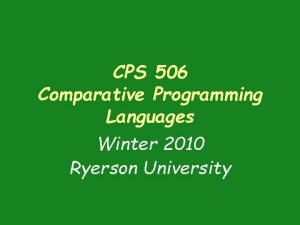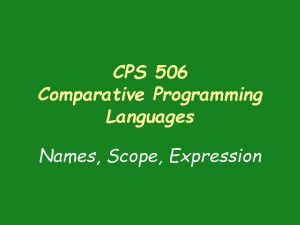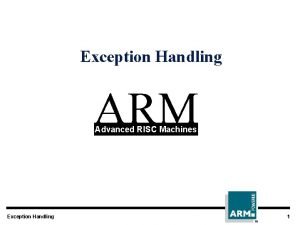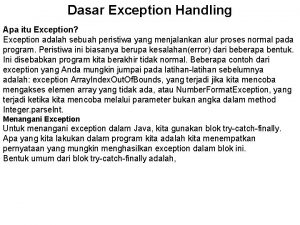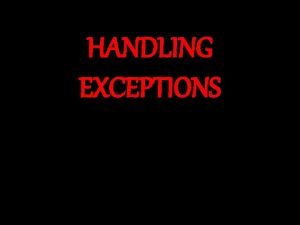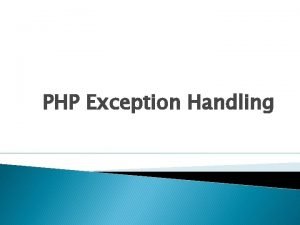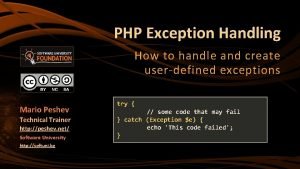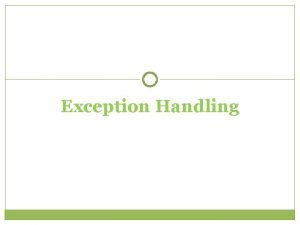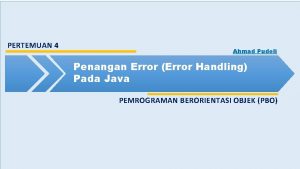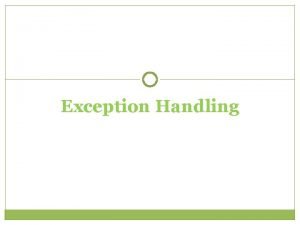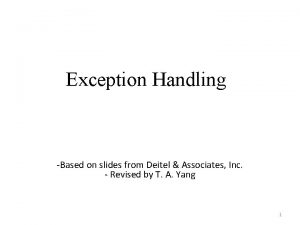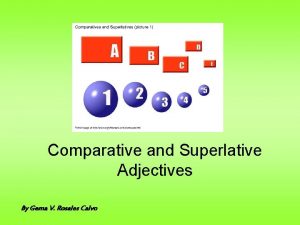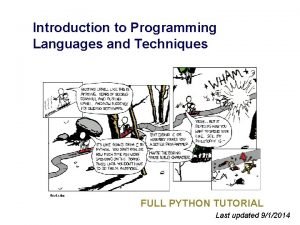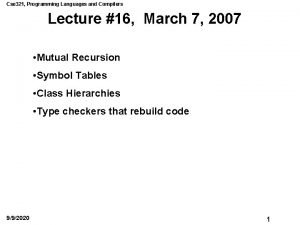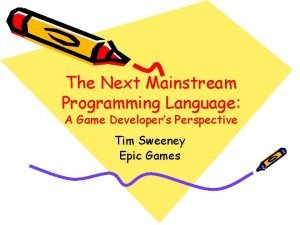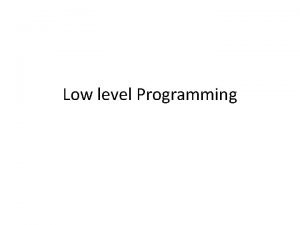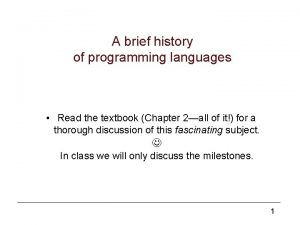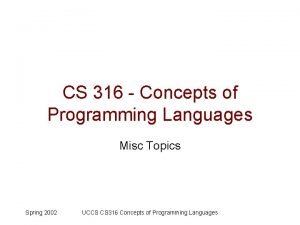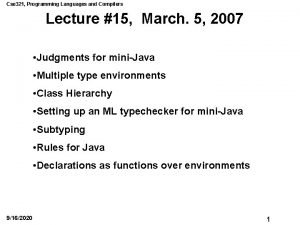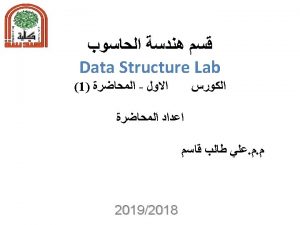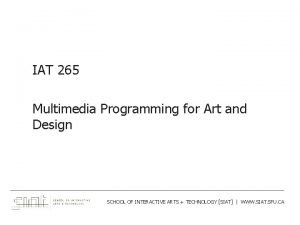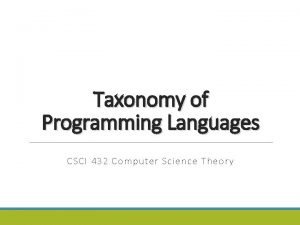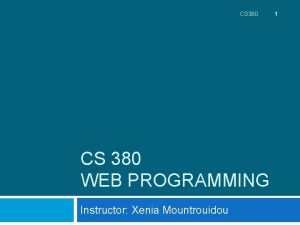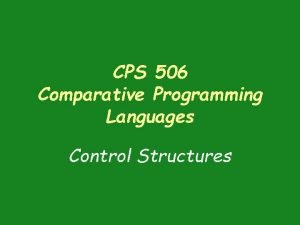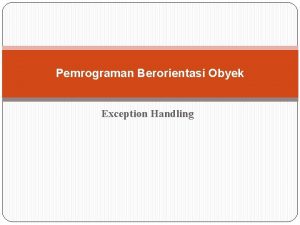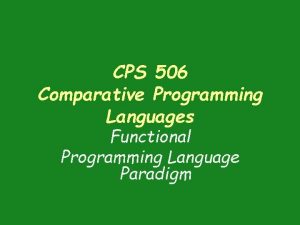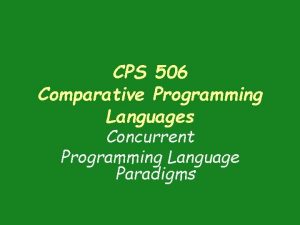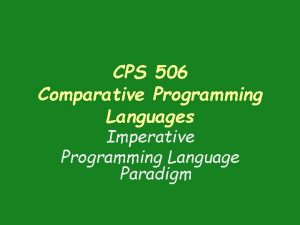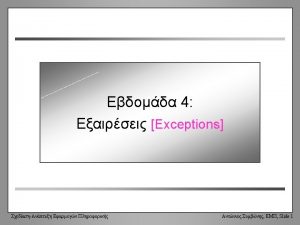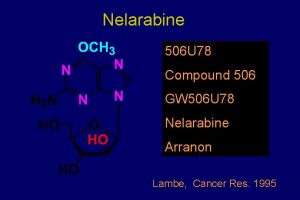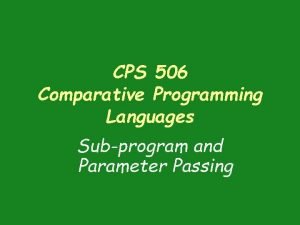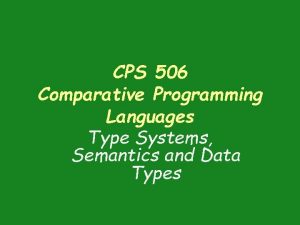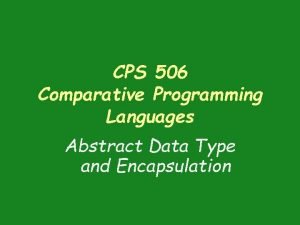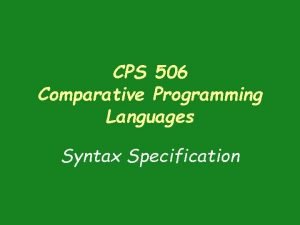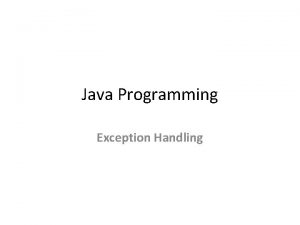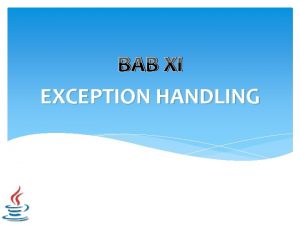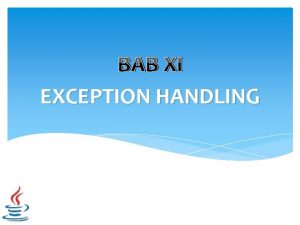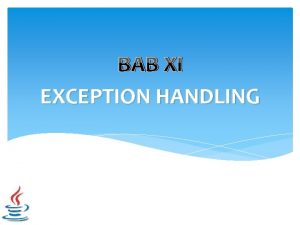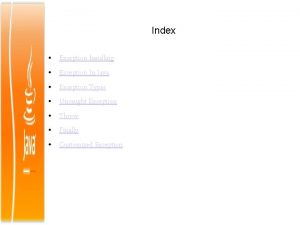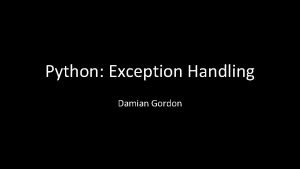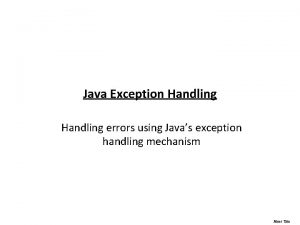CPS 506 Comparative Programming Languages Exception Handling Topics



















![Throwing Exceptions • Exceptions are all raised explicitly by the statement: throw [expression]; • Throwing Exceptions • Exceptions are all raised explicitly by the statement: throw [expression]; •](https://slidetodoc.com/presentation_image_h/89e71a13a2945d775209a9bf60b5bce3/image-20.jpg)













- Slides: 33

CPS 506 Comparative Programming Languages Exception Handling

Topics • • • Introduction to Exception Handling in Ada Exception Handling in C++ Exception Handling in Java Introduction to Event Handling with Java 2

Introduction to Exception Handling • In a language without exception handling – When an exception occurs • Control goes to the operating system • A message is displayed • The program is terminated • In a language with exception handling – Programs are allowed to • Trap some exceptions • Providing the possibility of fixing the problem • Continuing the program 3

Basic Concepts • Many languages allow programs to trap input/output errors (including EOF) • An exception is – Any unusual event • erroneous or not • Detectable by either hardware or software • May require special processing • The special processing that may be required after detection of an exception is called – Exception Handling • The exception handling code unit is called an – Exception Handler 4

Exception Handling Alternatives • An exception is raised when its associated event occurs • A language that does not have exception handling capabilities can still – Define – Detect – Raise – Handle exceptions (user defined, software detected) • Alternatives: – Send an auxiliary parameter or use the return value to indicate the return status of a subprogram – Pass a label parameter to all subprograms (error returns into the passed label) – Pass an exception handling subprogram to all subprograms 5

Advantages of Built-in Exception Handling • Error detection code – Is tedious to write – It clutters the program • Exception handling – Encourages programmers to consider many different possible errors • Exception propagation – Allows a high level of reuse of exception handling code 6

Design Issues • How and where are exception handlers specified? • What is their scope? • How is an exception occurrence bound to an exception handler? • Can information about the exception be passed to the handler? • Where does execution continue, if at all, after an exception handler completes its execution? (continuation vs. resumption) • Is some form of finalization provided? 7

Design Issues (con’t) • How are user-defined exceptions specified? • Should there be default exception handlers for programs that do not provide their own? • Can built-in exceptions be explicitly raised? • Are hardware-detectable errors treated as exceptions that can be handled? • Are there any built-in exceptions? • How can exceptions be disabled, if at all? 8

Exception Handling Control Flow 9

Exception Handling in Ada • The frame of an exception handler in Ada is either – A subprogram body – A package body – A task – Or a block • No parameter – Because exception handlers are usually local to the code in which the exception can be raised, they do not have parameters 10

Ada Exception Handlers • Handler form: when exception_choice{|exception_choice} => statement_sequence. . . [when others => statement_sequence] exception_choice form: exception_name | others • Handlers are placed at the end of the block or unit in which they occur 11

Binding Exceptions to Handlers • If the block or unit in which an exception is raised does not have a handler for that exception, the exception is propagated elsewhere to be handled – Procedures - propagate it to the caller – Blocks - propagate it to the scope in which it appears – Package body - propagate it to the declaration part of the unit that declared the package • If it is a library unit, which is separately compiled, the program is terminated – Task - no propagation • If it has a handler, execute it • In either case, mark it "completed" 12

Continuation • The block or unit that raises an exception, along with all units to which the exception was propagated but did not handle it is always terminated • Also any block or unit to which it is propagated that does not handle it, is terminated • Return to a higher level of control 13

Other Design Choices • Each predefined package has some exceptions • User-defined Exceptions form: exception_name_list : exception; – Should be raised explicitly – Raising Exceptions form: raise [exception_name] – The exception name is not required if it is in a handler--in this case, it propagates the same exception • Exception conditions can be disabled with: pragma Suppress(exception_list) 14

Predefined Exceptions • CONSTRAINT_ERROR - index constraints, range constraints, etc. • NUMERIC_ERROR - numeric operation cannot return a correct value (overflow, division by zero, etc. ) • PROGRAM_ERROR - call to a subprogram whose body has not been implemented • STORAGE_ERROR - system runs out of heap • TASKING_ERROR - an error associated with tasks 15

Evaluation • The Ada design for exception handling embodies the state-of-the-art in language design in 1980 • Ada was the only widely used language with exception handling until it was added to C++ 16

Exception Handling in C++ • Added to C++ in 1990 • Design is based on that of CLU, Ada, and ML 17

C++ Exception Handlers • Exception Handlers Form: try { -- code that is expected to raise an exception } catch (formal parameter) { -- handler code }. . . catch (formal parameter) { -- handler code } 18

The catch Function • catch is the name of all handlers--it is an overloaded name, so the formal parameter of each must be unique • The formal parameter need not have a variable – It can be simply a type name to distinguish the handler it is in from others • The formal parameter can be used to transfer information to the handler • The formal parameter can be an ellipsis, in which case it handles all exceptions not yet handled 19
![Throwing Exceptions Exceptions are all raised explicitly by the statement throw expression Throwing Exceptions • Exceptions are all raised explicitly by the statement: throw [expression]; •](https://slidetodoc.com/presentation_image_h/89e71a13a2945d775209a9bf60b5bce3/image-20.jpg)
Throwing Exceptions • Exceptions are all raised explicitly by the statement: throw [expression]; • The brackets are metasymbols, i. e. expression is optional • A throw without an operand can only appear in a handler; when it appears, it simply re-raises the exception • The type of the expression disambiguates the intended handler 20

Unhandled Exceptions • An unhandled exception is propagated to the caller of the function in which it is raised • This propagation continues to the main function • If no handler is found, the default handler is called 21

Continuation • After a handler completes its execution, control flows to the first statement following the try construct • Other design choices – All exceptions are user-defined – The default handler, unexpected, simply terminates the program 22

Exception Handling in Java • Based on that of C++, but more in line with OOP philosophy • All exceptions are objects of classes that are descendants of the Throwable class 23

Classes of Exceptions • The Java library includes two subclasses of Throwable : – Error • Is thrown by the Java interpreter for events such as heap overflow • Is never handled by user programs – Exception • User-defined exceptions are usually subclasses of this • Has two predefined subclasses – IOException – Runtime. Exception – Examples » Array. Index. Out. Of. Bounds. Exception » Null. Pointer. Exception 24

Java Exception Handlers • Like those of C++, except every catch requires a named parameter and all parameters must be descendants of Throwable • Syntax of try clause is exactly that of C++ • Exceptions are thrown with throw, as in C++, but often the throw includes the new operator to create the object, as in: throw new My. Exception(); 25

Binding Exceptions to Handlers • Binding an exception to a handler is simpler in Java than it is in C++ – An exception is bound to the first handler with a parameter is the same class as the thrown object or an ancestor of it • An exception can be handled and rethrown by including a throw in the handler (a handler could also throw a different exception) 26

Continuation • If no handler is found in the try construct, the search is continued in the nearest enclosing try construct, etc. • If no handler is found in the method, the exception is propagated to the method’s caller • If no handler is found (all the way to main), the program is terminated • To insure that all exceptions are caught, a handler can be included in any try construct that catches all exceptions – Simply use an Exception class parameter – Of course, it must be the last in the try construct 27

Checked and Unchecked Exceptions • The Java throws clause is quite different from the throw clause of C++ • Exceptions of class Error and Run. Time. Exception and all of their descendants are called unchecked exceptions; all other exceptions are called checked exceptions • Checked exceptions that may be thrown by a method must be either: – Listed in the throws clause, or – Handled in the method 28

Other Design Choices • A method cannot declare more exceptions in its throws clause than the method it overrides • No default exception handler • No possibility to disable exceptions • Continuation is the same as that in C++ 29

The finally Clause • Can appear at the end of a try construct • Form: finally {. . . } • Purpose: To specify code that is to be executed, regardless of what happens in the try construct 30

Example • A try construct with a finally clause can be used outside exception handling try { for (index = 0; index < 100; index++) { … if (…) { return; } //** end of if } //** end of try clause finally { … } //** end of try construct 31

Assertions • Statements in the program declaring a boolean expression regarding the current state of the computation • When evaluated to true nothing happens • When evaluated to false an Assertion. Error exception is thrown • Two forms assert condition; assert condition: expression; • Used for program correctness testing • Can be disabled during runtime without program modification or recompilation 32

Evaluation • The types of exceptions makes more sense than in the case of C++ – The throws clause is better than that of C++ (The throw clause in C++ says little to the programmer) – The finally clause is often useful – The Java interpreter throws a variety of exceptions that can be handled by user programs 33
 Cps 506
Cps 506 Cps 506
Cps 506 Imperative programming languages
Imperative programming languages No irq handler for vector
No irq handler for vector Exception handling pada java
Exception handling pada java Event handling in ada
Event handling in ada Exception handling pl/sql
Exception handling pl/sql Php exception example
Php exception example Php global exception handler
Php global exception handler Vb net try
Vb net try Exception handling pada java
Exception handling pada java Vb.net error handling
Vb.net error handling Exception handling in java
Exception handling in java Comparative for bad
Comparative for bad High level language
High level language Programming languages
Programming languages Mainstream programming languages
Mainstream programming languages Alternative programming languages
Alternative programming languages Cs 421 uiuc
Cs 421 uiuc Low level linux programming
Low level linux programming Brief history of programming languages
Brief history of programming languages Integral data types
Integral data types Introduction to programming languages
Introduction to programming languages If programming languages were cars
If programming languages were cars Cse 340 principles of programming languages
Cse 340 principles of programming languages Programming languages
Programming languages Strongly typed vs weakly typed
Strongly typed vs weakly typed Cs 421 uiuc
Cs 421 uiuc Middle level programming languages
Middle level programming languages Iat 265
Iat 265 Lisp_q
Lisp_q Real-time systems and programming languages
Real-time systems and programming languages Xenia programming languages
Xenia programming languages Plc programming languages
Plc programming languages
